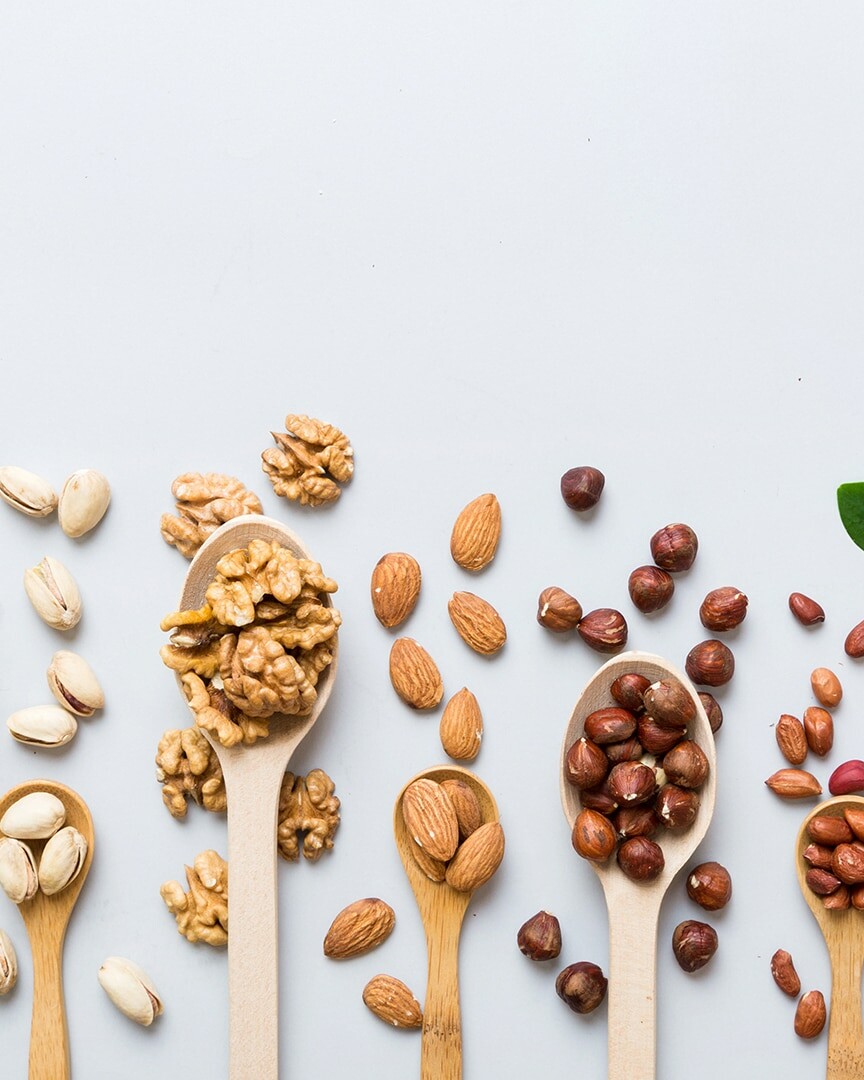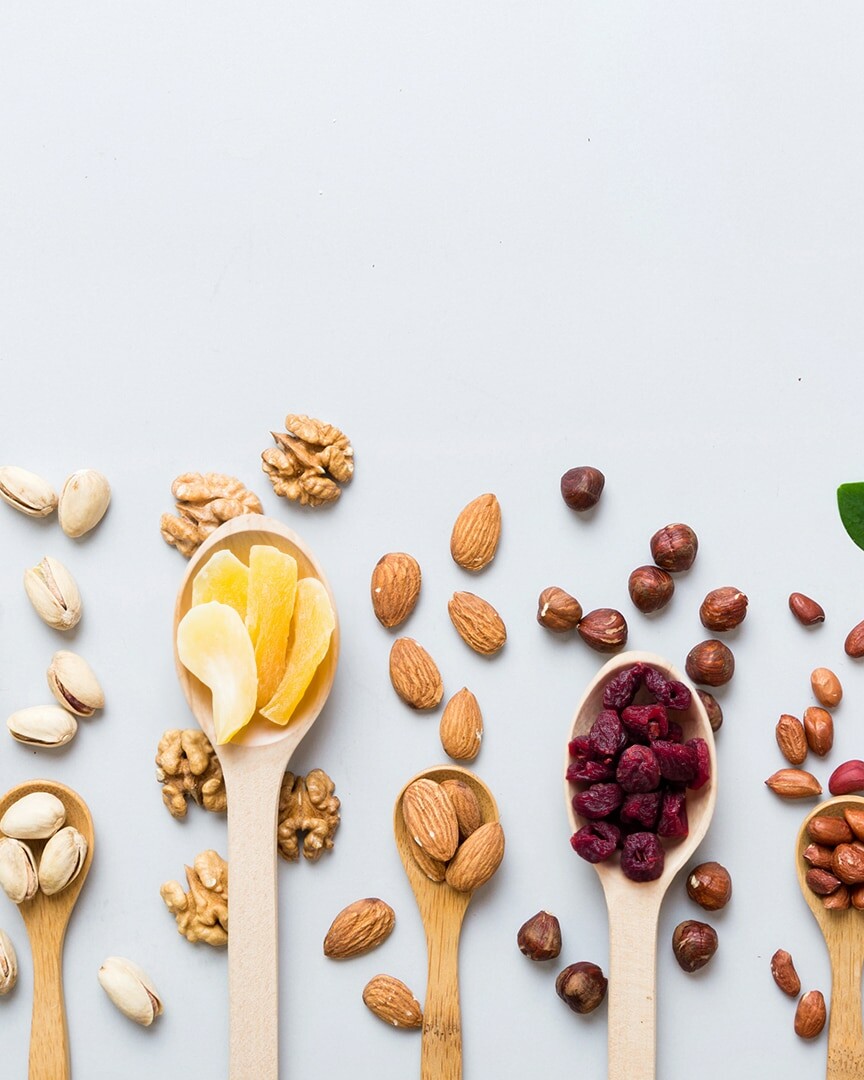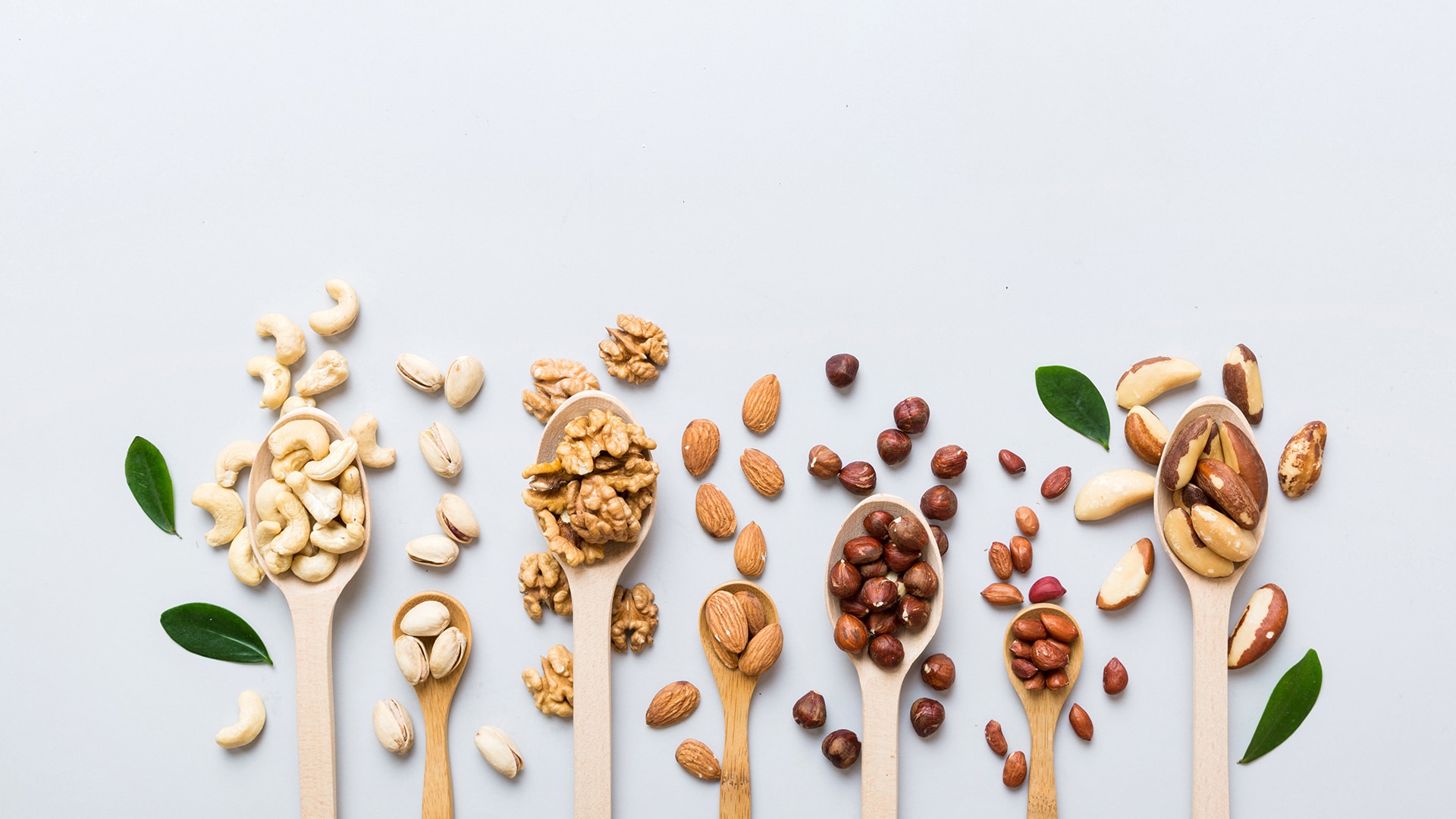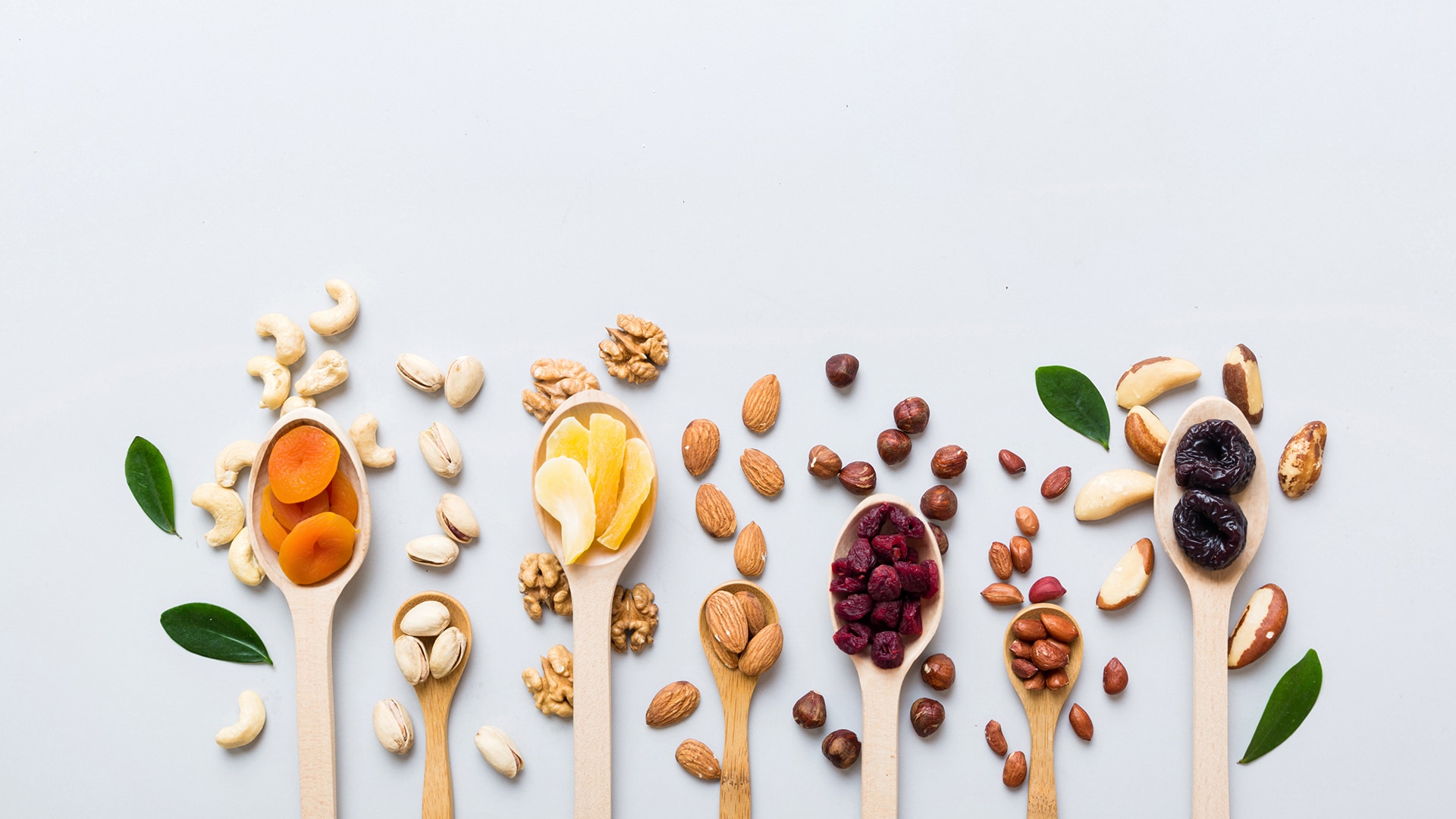Frutta Secca vs Frutta Disidratata:
ecco le Differenze!
La frutta secca e la frutta disidratata sono due tipi di alimenti salutari, ma presentano alcune differenze significative sia nel processo di produzione sia nelle caratteristiche nutrizionali. Ecco una panoramica su cosa dovresti sapere in merito alle loro differenze principali.
Frutta Secca
vs Frutta Disidratata:
ecco le Differenze!
La frutta secca e la frutta disidratata sono due tipi di alimenti salutari, ma presentano alcune differenze significative sia nel processo di produzione sia nelle caratteristiche nutrizionali. Ecco una panoramica su cosa dovresti sapere in merito alle loro differenze principali.
Dried Fruit
Dried Fruits are those that naturally contain a low water content. These terms generally refer to nuts such as walnuts, almonds, hazelnuts, pistachios, etc. This category of foods also includes oilseeds such as pumpkin seeds, sesame seeds, sunflower seeds, and flax seeds, which have similar nutritional characteristics to nuts.
Dehydrated Fruit
Fresh fruit from which much of the water has been removed through a dehydration process is dehydrated. The main foods that are often taken after undergoing dehydration treatment are apples, bananas, grapes, plums, apricots, pineapples, and many other fruits but not only that, also potatoes, carrots, tomatoes, peppers, onions, garlic, and many other vegetables.
Dried Fruit
Dried Fruits are those that naturally contain a low water content. These terms generally refer to nuts such as walnuts, almonds, hazelnuts, pistachios, etc.
Dehydrated Fruit
It is the fresh fruit from which most of the water has been removed through a dehydration process. These are usually apples, bananas, grapes, plums, apricots, pineapples, and many other fruits as well as vegetables.
Production Process
Di solito, la frutta secca cresce e matura con un basso contenuto di acqua. Non viene sottoposta a un processo di disidratazione.
Production Process
La frutta fresca viene sottoposta a un processo di disidratazione, attraverso il quale la maggior parte dell’acqua viene rimossa. Questo processo può essere realizzato in vari modi, come l’essiccazione al sole, l’essiccazione ad aria calda, o l’uso di un disidratatore.
Nutrients
Ricca di grassi salutari, vitamine B ed E, proteine (circa il 12-13% per 100 g di alimento), fibre, e micronutrienti.
Nutrients
Conserva la maggior parte delle vitamine e dei minerali presenti nella frutta fresca, ma la concentrazione di zuccheri e calorie sarà più alta a causa della riduzione del contenuto di acqua.
Le informazioni nutrizionali possono variare in base alla specifica varietà e metodo di preparazione. È sempre meglio controllare le etichette dei prodotti per informazioni precise.
Calories
Tende ad essere più calorica a causa dell’alto contenuto di grassi.
Calories
Ha un contenuto calorico più elevato rispetto alla frutta fresca (su base di peso) a causa della riduzione del contenuto di acqua.
Texture
Di solito ha una texture croccante.
Texture
Morbida e gommosa o croccante, a seconda del processo di disidratazione utilizzato.
Storage and Durability
Ha una lunga durata, e può essere conservata per un lungo periodo senza deteriorarsi, a patto che sia conservata in modo appropriato.
Storage and Durability
Anch’essa ha una durata piuttosto lunga, specialmente se conservata in contenitori ermetici per prevenire l’assorbimento di umidità.
Le dosi giornaliere consigliate di frutta secca e frutta disidratata possono variare in base a diversi fattori come l'età, il sesso, il livello di attività fisica, e le esigenze caloriche individuali.
Recommended daily doses
Here are some general guidelines
Frutta Secca come noci, mandorle, nocciole, pistacchi
Una dose tipica è di circa 28-30 grammi, che equivale approssimativamente a un pugno o una manciata. Questa quantità fornisce un buon equilibrio di nutrienti senza un eccessivo apporto calorico.
Nota La frutta secca è densa dal punto di vista nutrizionale e calorico, quindi è meglio consumarla con moderazione. Essa può fornire una buona quantità di grassi salutari, proteine, fibre, vitamine e minerali.
Recommended daily doses
Here are some general guidelines
Frutta Disidratata
Una dose tipica può variare, ma generalmente si aggira intorno ai 15-30 grammi. Questa quantità può fornire una buona dose di fibre, vitamine e minerali.
Nota Dato che l’acqua è stata rimossa dalla frutta disidratata, essa è più concentrata in termini di zuccheri e calorie rispetto alla sua controparte fresca. Pertanto, è consigliabile consumarla con moderazione per evitare un eccessivo apporto di zuccheri e calorie.
Production Process
Dried Fruit
Di solito, la frutta secca cresce e matura con un basso contenuto di acqua. Non viene sottoposta a un processo di disidratazione.
Dehydrated Fruit
La frutta fresca viene sottoposta a un processo di disidratazione, attraverso il quale la maggior parte dell’acqua viene rimossa. Questo processo può essere realizzato in vari modi, come l’essiccazione al sole, l’essiccazione ad aria calda, o l’uso di un disidratatore.
Nutrients
Dried Fruit
Ricca di grassi salutari, vitamine B ed E, proteine (circa il 12-13% per 100 g di alimento), fibre, e micronutrienti.
Dehydrated Fruit
Conserva la maggior parte delle vitamine e dei minerali presenti nella frutta fresca, ma la concentrazione di zuccheri e calorie sarà più alta a causa della riduzione del contenuto di acqua.
Le informazioni nutrizionali possono variare in base alla specifica varietà e metodo di preparazione. È sempre meglio controllare le etichette dei prodotti per informazioni precise.
Calories
Dried Fruit
Tende ad essere più calorica a causa dell’alto contenuto di grassi.
Dehydrated Fruit
Ha un contenuto calorico più elevato rispetto alla frutta fresca (su base di peso) a causa della riduzione del contenuto di acqua.
Texture
Dried Fruit
Di solito ha una texture croccante.
Dehydrated Fruit
Morbida e gommosa o croccante, a seconda del processo di disidratazione utilizzato.
Storage and Durability
Dried Fruit
Ha una lunga durata, e può essere conservata per un lungo periodo senza deteriorarsi, a patto che sia conservata in modo appropriato.
Dehydrated Fruit
Anch’essa ha una durata piuttosto lunga, specialmente se conservata in contenitori ermetici per prevenire l’assorbimento di umidità.
Le dosi giornaliere consigliate di frutta secca e frutta disidratata possono variare in base a diversi fattori come l'età, il sesso, il livello di attività fisica, e le esigenze caloriche individuali.
Recommended daily doses
Here are some general guidelines
Dried Fruit
Come noci, mandorle, nocciole, pistacchi, noci…
Una dose tipica è di circa 28-30 grammi, che equivale approssimativamente a un pugno o una manciata. Questa quantità fornisce un buon equilibrio di nutrienti senza un eccessivo apporto calorico.
Nota La frutta secca è densa dal punto di vista nutrizionale e calorico, quindi è meglio consumarla con moderazione. Essa può fornire una buona quantità di grassi salutari, proteine, fibre, vitamine e minerali.
Dehydrated Fruit
Una dose tipica può variare, ma generalmente si aggira intorno ai 15-30 grammi. Questa quantità può fornire una buona dose di fibre, vitamine e minerali.
Nota Dato che l’acqua è stata rimossa dalla frutta disidratata, essa è più concentrata in termini di zuccheri e calorie rispetto alla sua controparte fresca. Pertanto, è consigliabile consumarla con moderazione per evitare un eccessivo apporto di zuccheri e calorie.
General Considerations: Balance and Variety.
La frutta secca può essere un’aggiunta preziosa a una dieta equilibrata, tuttavia, è importante notare che, a causa della sua alta densità di nutrienti, è anche un alimento calorico. Pertanto, il suo consumo dovrebbe essere moderato e bilanciato con altri alimenti nel corso della giornata per garantire un apporto nutrizionale vario e bilanciato. Variare i tipi di frutta secca e disidratata che consumi può aiutare a garantire un’ampia gamma di nutrienti. Infine, come detto, è importante prestare attenzione alle porzioni per evitare un eccessivo apporto calorico.
Ricorda, queste sono solo linee guida generali e potrebbe essere utile consultare un professionista della salute o un nutrizionista per consigli personalizzati.
Sofia
My name is Sofia, and I am a Blogger. I write posts about dietary supplements, including their health benefits, recommended uses, potential interactions, and side effects. To report any inaccuracies, errors, or typos, feel free to write to me at redazione@encanto.it.
Related Contents
Proactive or Reactive Approach?
In health terms, the Proactive or Reactive approach refers to how an individual manages his or her health and well-being.




